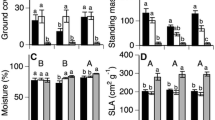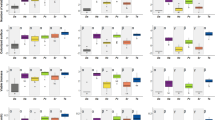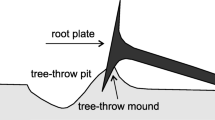Abstract
Mosses are a dominant ground cover in a wide array of ecosystems, especially in those developing under cold-stressed environments such as arctic and alpine ice-melting glacial forelands. Consequently, mosses may influence the performance and distribution of other plants. Here, we assessed the nature of interactions between vascular plants and cushion-forming mosses in three alpine communities in the northern Patagonian Andes. We recorded species richness, plant abundance and cover of vascular plants within and outside moss cushions, measuring also patch area and moss layer depth. To determine the effect of mosses on vascular plant assemblages, we calculated the relative interaction index (RII) in terms of richness, abundance and cover of all vascular plants, and of individual species. Moss-cushion patches showed higher species richness, plant abundance and cover in comparison with bare ground areas. Overall, the diversity of vascular plants increased with both moss-cushion area and layer depth. Species-specific RII values revealed that the effects of moss cushions on neighboring vascular plants were predominantly positive for all three plant communities surveyed. These results highlight the role of mosses as nurse plants in alpine ice-melting glacial forelands and, thus, as ecosystem engineers that can be key in maintaining vascular plant diversity.






Similar content being viewed by others
References
Anthelme F, Buendia B, Mazoyer C, Dangles O (2012) Unexpected mechanisms sustain the stress-gradient hypothesis in a tropical alpine environment. J Veg Sci 23:62–72
Armas C, Ordiales R, Pugnaire F (2004) Measuring plant interactions: a new comparative index. Ecology 85:2682–2686
Arróniz-Crespo M, Perez-Ortega S, De los Ríos A, Green TGA, Ochoa-Hueso R et al (2014) Bryophyte-Cyanobacteria associations during primary succession in recently deglaciated areas of Tierra del Fuego (Chile). PLoS One 9(5):e96081
Aubert S, Boucher F, Lavergne S, Renaud J, Choler P (2014) 1914–2014: a revised worldwide catalogue of cushion plants 100 years after Hauri and Schröter. Alpine Bot 124(1):59–70
Bai Y, Romo JT (1995) Seedling emergence of Artemisia frigida in relation to hydration-dehydration cycles and seedbed characteristics. J Arid Environ 30:57–65
Bates D, Maechler M, Bolker B, Walker S (2015) Fitting linear mixed-effects models using lme4. J Stat Softw 67:1–48
Belkina OA, Mavlyudov BR (2011) Mosses on glaciers of Spitsbergen. Bot Zhurn 96(5):582–596
Belkina OA, Vilnet AA (2015) Some aspects of the moss population development on the Svalbard glaciers. Czech Polar Rep 5(2):160–175
Beringer J, Lynch AH, Chapin FS, Mack M, Bonan GB (2001) The representation of arctic soils in the land surface model: the importance of mosses. J Clim 14:3324–3335
Bertness MD, Callaway RM (1994) Positive interactions in communities. Trends Ecol Evol 9:191–193
Bliss LC (1962) Adaptations of arctic and alpine plants to environmental conditions. Arctic 15:117–144
Block W, Smith RIL, Kennedy AD (2009) Strategies of survival and resource exploitation in the Antarctic fellfield ecosystem. Biol Rev 84:449–484
Bonanomi G, Stinca A, Chirico GB, Ciaschetti G, Saracino A, Incerti G (2015) Cushion plant morphology controls biogenic capability and facilitation effects of Silene acaulis along an elevation gradient. Funct Ecol 30:1216–1226
Bret-Harte MS, García EA, Sacre VM, Whorley JR, Wagner JL, Lippert SC, Scarano FR, Chapin FS (2004) Plant and soil responses to neighbour removal and fertilization in Alaskan tussock tundra. J Ecol 92:635–647
Brooker RW, Callaghan TV (1998) The balance between positive and negative plant interactions and its relationship to environmental gradients: a model. Oikos 81:196–207
Brooker RW, Maestre FT, Callaway RM, Lortie CJ, Cavieres LA, Kunstler G, Liancourt P, Tielbörger K, Travis MJT et al (2008) Facilitation in plant communities: the past, the present and the future. J Ecol 96:18–34
Bruun HH, Moen J, Virtanen R, Grytnes J, Oksanen L, Angerbjörn A (2006) Effects of altitude and topography on species richness of vascular plants, bryophytes and lichens in alpine communities. J Veg Sci 17:37–46
Butterfield BJ, Cavieres LA, Callaway RM, Cook BJ, Kikvidze Z, Lortie CJ, Michalet R et al (2013) Alpine cushion plants inhibit the loss of phylogenetic diversity in severe environments. Ecol Lett 16:478–486
Callaway RM, Brooker RW, Choler P, Kikvidze Z, Lortie CJ, Newingham B, Aschehoug ET, Armas C, Kikodze D, Cook BJ (2002) Positive interactions among alpine plants increase with stress. Nature 417:844–848
Carlsson BA, Callaghan TV (1991) Positive plant interactions in tundra vegetation and the importance of shelter. J Ecol 79:973–983
Casanova-Katny A, Cavieres LA (2012) Antarctic moss carpets facilitate growth of Deschampsia antarctica, but not its survival. Polar Biol 35:1869–1878
Cavieres LA, Quiroz CL, Molina-Montenegro MA, Muñoz AA, Pauchard A (2005) Nurse effect of the native cushion plant Azorella monantha on the invasive non-native Taraxacum officinale in the high-Andes of central Chile. Perspect Plant Ecol Syst 7:217–226
Cavieres LA, Badano EI, Sierra-Almeida A, Gómez-González S, Molina-Montenegro MA (2006) Positive interactions between alpine plant species and the nurse cushion plant Laretia acaulis do not increase with elevation in the Andes of central Chile. New Phytol 169:59–69
Cavieres LA, Brooker RW, Butterfield BJ et al (2014) Facilitative plant interactions and climate simultaneously drive alpine plant diversity. Ecol Lett 17:193–202
Choler P, Michalet R, Callaway RM (2001) Facilitation and competition on gradients in alpine plant communities. Ecology 82:3295–3308
Colwell RK (2013) EstimateS: statistical estimation of species richness and shared species from samples. Version 9.1.0. (Software and User’s Guide). http://purl.oclc.org/estimates
Damgaard C, Merlin A, Mesléard F, Bonis A (2011) The demography of space occupancy: measuring plant colonisation and survival probabilities using repeated pin-point measurements. Methods Ecol Evol 2:110–115
De Bello F, Dolezal J, Dvorsky M, Chlumska Z, Rehakova K, Klimesova J, Klimes L (2011) Cushions of Thylacospermum caespitosum (Caryophyllaceae) do not facilitate other plants under extreme altitude and dry conditions in the north-west Himalayas. Ann Bot 108:567–573
Dickson JH, Johnson RE (2014) Mosses and the beginnings of plant succession on the Walker Glacier, southeastern Alaska. Lindbergia 37:60–65
Donath TW, Eckstein RL (2010) Effects of bryophytes and grass litter on seedling emergence vary by vertical seed position and seed size. Plant Ecol 207:257–268
Doxford SW, Ooi MKJ, Freckleton RP (2013) Spatial and temporal variability in positive and negative plant–bryophyte interactions along a latitudinal gradient. J Ecol 101:465–474
Dvorsky M, Dolezal J, Kopecky M, Chlumska Z, Janatkova K, Altman J et al (2013) Testing the Stress-Gradient Hypothesis at the roof of the world: effects of the cushion plant Thylacospermum caespitosum on species assemblages. PLoS One 8:e53514
Erschbamer B, Niederfriniger Schlag R, Winkler E (2008) Colonization processes on a central Alpine glacier foreland. J Veg Sci 19:855–862
Erzberger P, Schröder W (2013) The genus Bryum (Bryaceae, Musci) in Hungary. Studia bot hung 44:5–192
Ferreyra M, Cingolani A, Ezcurra C, Bran D (1998) High-Andean vegetation and environmental gradients in northwestern Patagonia, Argentina. J Veg Sci 9(3):307–316
Gardes M, Dahlberg A (1996) Mycorrhizal diversity in arctic and alpine tundra: an open question. New Phytol 133:147–157
Garibotti IA, Pissolito CI, Villalba R (2011) Vegetation development on deglaciated rock outcrops from Glaciar Frías, Argentina. Arct Antarct Alp Res 43:35–45
Gomez-Aparicio L (2009) The role of plant interactions in the restoration of degraded ecosystems: a meta-analysis across life-forms and ecosystems. J Ecol 97:1202–1214
Gornall JL, Jonsdottir IS, Woodin SJ, Van der Wal R (2007) Arctic mosses govern below-ground environment and ecosystem processes. Oecologia 153:931–941
Gornall JL, Woodin SJ, Jonsdottir IS, Van der Wal R (2011) Balancing positive and negative plant interactions: how mosses structure vascular plant communities. Oecologia 166:769–782
Gotelli NJ, Colwell RK (2011) Estimating species richness. In: Magurran AE, McGill BJ (eds) Frontiers in measuring biodiversity. Oxford University Press, New York, pp 39–54
Gradstein SR, Churchill SP, Salazar-Allen N (2001) Guide to the bryophytes of tropical America. Memoirs of the New York Botanical Garden, vol 86
Groeneveld EVG, Rochefort L (2005) Polytrichum strictum as a solution to frost heaving in disturbed ecosystems: a case study with milled Peatlands. Restor Ecol 13:74–82
Groeneveld EVG, Masse A, Rochefort L (2007) Polytrichum strictum as a nurse-plant in Peatland restoration. Restor Ecol 15:709–719
Hijmans RJ, Cameron SE, Parra JL, Jones PG, Jarvis A (2005) Very high resolution interpolated climate surfaces for global land areas. Int J Clim 25:1965–1978
Hobbie SE, Shevtsova A, Chapin FS (1999) Plant responses to species removal and experimental warming in Alaskan tussock tundra. Oikos 84:417–434
Jeschke M, Kiehl K (2008) Effects of a dense moss layer on germination and establishment of vascular plants in newly created calcareous grasslands. Flora 203:557–566
Jimenez MS, Suárez GM (2017) Philonotis pomangium (Bartramiaceae, Bryophyta): an addition to the Bryoflora of Peru. Bol Soc Argent Bot 52(2):341–350
Jimenez MS, Suárez GM, Schiavone MM (2014) Fruiting material of Philonotis esquelensis Matteri (Bartramiaceae, Bryophyta) discovered in Chile. Bol Soc Argent Bot 49(4):463–471
Jimenez MS, Suárez GM, Larraín J (2016) Rediscovery and lectotypification of Philonotis brevifolia Herzog. (Bartramiaceae, Bryophyta), a neglected species from Chile. Cryptogam Bryol 37(2):1–6
Johnstone JF, Chapin FS III, Hollingsworth TN, Me Mack, Romanovsky V, Turetsky M (2010) Fire, climate change, and forest resilience in interior Alaska. Can J For Res 40(7):1302–1312
Jones GA, Henry GHR (2003) Primary plant succession on recently deglaciated terrain in the Canadian High Arctic. J Biogeogr 30(2):277–296
Körner C (2003) Alpine plant life, 2nd edn. Springer, Berlin
Krna MA, Day TA, Ruhland CT (2009) Effects of neighboring plants on the growth and reproduction of Deschampsia antarctica in Antarctic tundra. Polar Biol 32:1487–1494
Larraín J (2007) Adiciones a la flora de musgos de la isla grande de chiloe, Chile. Gayana Bot 64(1):7–23
Maestre FT, Callaway RM, Valladares F, Lortie CJ (2009) Refining the stress-gradient hypothesis for competition and facilitation in plant communities. J Ecol 97:199–205
Malmer N, Albinsson C, Svensson BM, Wallen B (2003) Interferences between Sphagnum and vascular plants: effects on plant community structure and peat formation. Oikos 100:469–482
Marcante S, Kiebacher T, Erschbamer B (2013) Reproductive responses of glacier foreland species to simulated climate change. Coll Phytosociol 29:361–373
Michalet R, Xiao S, Touzard B, Smith DS, Cavieres LA, Callaway RM, Whitham TG (2011) Phenotypic variation in nurse traits and community feedbacks define an alpine community. Ecol Lett 14:433–443
Michalet R, Schob C, Lortie CJ, Brooker RW, Callaway RM (2014) Partitioning net interactions among plants along altitudinal gradients to study community responses to climate change. Funct Ecol 28:75–86
Molau U (1997) Age-related growth and reproduction in Diapensia lapponica, an arctic-alpine cushion plant. Nord J Bot 17:225–234
Morris WF, Doak DF (1998) Life history of the long-lived gynodioecious cushion plant Silene acaulis (Caryophyllaceae), inferred from size-based population projection matrices. Am J Bot 85:784–793
Navas ML, Violle C (2009) Plant traits related to competition: how do they shape the functional diversity of communities? Community Ecol 10:131–137
Niederfriniger Schlag R, Erschbamer B (2000) Germination and establishment of seedlings on a glacier foreland in the Central Alps, Austria. Arct Antarct Alp Res 32:270–277
Nuñez C, Aizen M, Ezcurra C (1999) Species associations and nurse plant effects in patches of high-Andean vegetation. J Veg Sci 10:357–364
Olofsson J, Kitti H, Rautiainen P, Stark S, Oksanen L (2001) Effects of summer grazing by reindeer on composition of vegetation, productivity and nitrogen cycling. Ecography 24:13–24
Olofsson J, Stark S, Oksanen L (2004) Reindeer influence on ecosystem processes in the tundra. Oikos 105:386–396
R Development Core Team (2017) R: a language and environment for statistical computing. R Foundation for Statistical Computing, Vienna, Austria. https://www.R-project.org
Rayburn AP, Davidson JB, White HM (2012) Possible effects of moss on distribution and performance of a threatened endemic primrose. West N Am Nat 72:84–92
Rice WR (1989) Analyzing tables of statistical tests. Evolution 43:223–225
Roberts P, Newsham KK, Bardgett RD, Farrar JF, Jones DL (2009) Vegetation cover regulates the quantity, quality and temporal dynamics of dissolved organic carbon and nitrogen in Antarctic soils. Polar Biol 32:999–1008
Sand-Jensen K, Hammer KJ, Madsen-Østerbye M, Dencker T, Kragh T (2015) Positive interactions between moss cushions and vascular plant cover improve water economy on Öland’s alvar, Sweden. Botany 93(3):141–150
Schöb C, Armas C, Guler M, Prieto I, Pugnaire FI (2013) Variability in functional traits mediates plant interactions along stress gradients. J Ecol 101:753–762
Smith RIL (1988) Recording bryophyte microclimate in remote and severe environments. In: Glime JM (ed) Methods in bryology. Hattori Botanical Laboratory, Nichinan, pp 275–284
Sohlberg EH, Bliss LC (1984) Microscale pattern of vascular plant distribution in two High Arctic plant communities. Can J Bot 62:2033–2042
Startsev NA, LieVers VJ, McNabb DH (2007) Effects of feathermoss removal, thinning and fertilization on lodgepole pine growth, soil microclimate and stand nitrogen dynamics. For Ecol Manag 240:79–86
Startsev N, LieVers VJ, Landhausser SM (2008) Effects of leaf litter on the growth of boreal feather mosses: implication for forest floor development. J Veg Sci 19:253–260
Suárez GM, Schiavone MM (2011) Pohlia section Pohlia (Bryaceae) in Central and South America. Nova Hedwigia 92(3–4):453–477
Turetsky MR, Mack MC, Hollingsworth TN, Harden JW (2010) The role of mosses in ecosystem succession and function in Alaska’s boreal forest. Can J For Res 40:1237–1264
Van der Wal R, Brooker RW (2004) Mosses mediate grazer impacts on grass abundance in arctic ecosystems. Funct Ecol 18:77–86
Van der Wal R, Pearce ISK, Brooker RW (2005) Mosses and the struggle for light in a nitrogen-polluted world. Oecologia 142:159–168
Wang GX, Li YS, Wu QB, Wang Y (2006) Impacts of permafrost changes on alpine ecosystem in Qinghai-Tibet Plateau. Sci China Ser D Earth Sci 49(11):1156–1169
Yang Y, Chen JG, Schöb C, Sun H (2017) Size-mediated interaction between a cushion species and other non-cushion species at high elevations of the Hengduan mountains, SW China. Front Plant Sci 8:465
Zuur AF, Leno EN, Walker NJ, Saveliev AA, Smith GM (2009) Mixed effects models and extensions in ecology. Springer, New York
Acknowledgements
The authors thank two anonymous reviewers and A. Sáez for useful comments and suggestions. We are grateful to the Administración de Parques Nacionales, Argentina, which provided permission to work at the study sites. This research was supported by the National Research Council of Argentina (CONICET) doctoral scholarship to S.S.G. G.M.S, C.E. and M.A.A are career researchers of CONICET.
Funding
Not applicable.
Author information
Authors and Affiliations
Contributions
SSG and MAA conceived the study. SSG collected field data. GMS identified the bryophytes. CE contributed materials and taxonomy expertise. SSG performed the analyses and wrote the first draft of the manuscript. All authors assisted with the writing of the manuscript and provided comments and edits.
Corresponding author
Ethics declarations
Conflict of interest
The authors declare that they have no conflict of interest.
Additional information
Publisher's Note
Springer Nature remains neutral with regard to jurisdictional claims in published maps and institutional affiliations.
Electronic supplementary material
Below is the link to the electronic supplementary material.
35_2019_222_MOESM1_ESM.pdf
Additional supporting information in the online version of this article (see Supplementary Material) contains: the list of additional studied sites assessing the effect of angiosperm-cushions plants, and the individual responses of vascular plant species to mosses (PDF 1747 kb)
Rights and permissions
About this article
Cite this article
Gavini, S.S., Suárez, G.M., Ezcurra, C. et al. Facilitation of vascular plants by cushion mosses in high-Andean communities. Alp Botany 129, 137–148 (2019). https://doi.org/10.1007/s00035-019-00222-6
Received:
Accepted:
Published:
Issue Date:
DOI: https://doi.org/10.1007/s00035-019-00222-6




